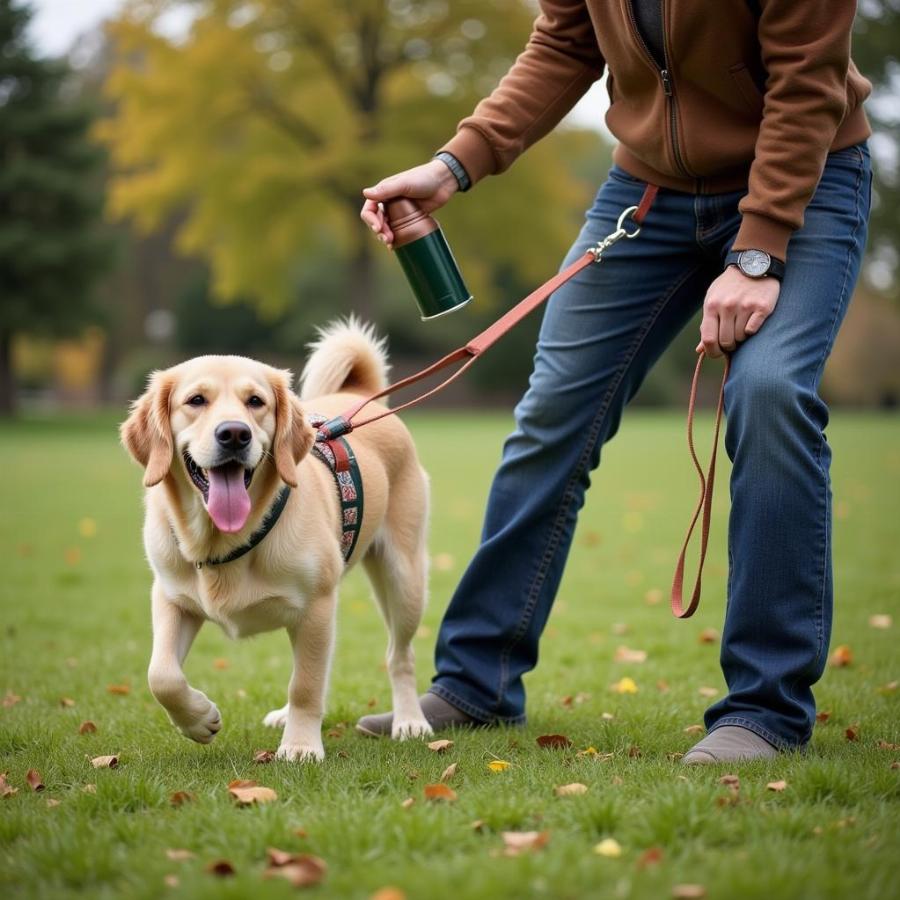Bitter spray for dogs is a popular training tool used to deter unwanted chewing and licking behaviors. Whether your furry friend is nibbling on furniture, gnawing at their paws, or constantly licking a wound, a bitter spray can offer a safe and effective solution. Understanding how these sprays work, how to choose the right one, and how to use them effectively is crucial for achieving the desired results and ensuring your dog’s well-being.
Understanding Bitter Spray for Dogs
Why do dogs dislike bitter tastes? Much like humans, dogs have taste receptors that detect bitterness. This evolutionary adaptation helps them avoid potentially poisonous plants and substances. Bitter sprays capitalize on this natural aversion to deter dogs from engaging in undesirable behaviors. They are formulated with extremely bitter, yet non-toxic ingredients that make the sprayed surface unpleasant for your dog to lick or chew.
How Bitter Sprays Work
Bitter sprays work by creating a negative association with the object or area being sprayed. When your dog licks or chews the sprayed surface, they experience an unpleasant taste, which discourages them from repeating the behavior. Over time, they learn to avoid the sprayed items altogether. This is a humane and effective way to modify behavior without resorting to physical punishment.
Choosing the Right Bitter Spray
With various bitter sprays available on the market, selecting the right one can seem daunting. Look for sprays specifically formulated for dogs, ensuring they are non-toxic and safe for your pet.
Key Factors to Consider:
- Ingredients: Opt for natural, non-toxic ingredients like bitter apple or citrus extracts. Avoid sprays containing alcohol or other harsh chemicals.
- Application: Consider where you’ll be using the spray. Some sprays are better suited for fabrics, while others are designed for hard surfaces.
- Dog’s Sensitivity: Some dogs are more sensitive to bitter tastes than others. Start with a milder spray and adjust as needed.
Using Bitter Spray Effectively
Applying bitter spray correctly is essential for its effectiveness.
Step-by-step guide:
- Clean the area: Before spraying, clean the surface to remove any dirt or debris.
- Test in a small area: Test the spray on an inconspicuous area first to ensure it doesn’t stain or damage the material.
- Apply the spray: Spray a thin, even coat on the target area.
- Reapply regularly: The bitterness fades over time, so reapply the spray every few days or as needed.
- Supervise your dog: Monitor your dog’s behavior initially to ensure they are not licking or chewing the sprayed surface.
 Spraying bitter spray on a leash
Spraying bitter spray on a leash
Addressing Common Concerns
Is bitter spray safe for puppies? Yes, most bitter sprays are safe for puppies, but always check the label for age recommendations. Choose a spray with natural ingredients and avoid spraying directly onto the puppy’s fur or skin.
“Consistency is key when using bitter spray,” advises Dr. Emily Carter, DVM. “Dogs learn through repetition, so be patient and consistent with the application to achieve the desired results.”
Conclusion
Bitter spray for dogs can be a valuable tool in preventing unwanted chewing and licking. By understanding how to choose and use these sprays effectively, you can help your furry friend develop good habits and protect your belongings. Remember to choose a safe and non-toxic spray, apply it correctly, and be patient with the training process. homemade bitter spray for dogs can also be an option for those who prefer a DIY approach.
FAQs
- Can bitter spray be used on wounds? Some bitter sprays are specifically designed for wounds, but always consult your veterinarian before using any product on a wound.
- What if my dog still licks the sprayed area? Some dogs are less sensitive to bitter tastes. Try a different brand or bitter apple spray for dogs.
- Is bitter spray harmful if ingested? While generally safe, excessive ingestion can cause gastrointestinal upset. Contact your veterinarian if you suspect your dog has ingested a large amount of bitter spray.
- Can bitter spray be used on furniture? Yes, many bitter sprays are safe for use on furniture. Always test in an inconspicuous area first.
- How often should I reapply the spray? Reapply every few days or as needed.
- What are some alternatives to bitter spray? Training, providing chew toys, and managing your dog’s environment are effective alternatives.
- Can I make my own bitter spray? Yes, you can find recipes online for homemade bitter spray for dogs.
“Understanding your dog’s individual needs and motivations is essential for effective training,” says Dr. Michael Davis, certified dog trainer. “Bitter spray can be a helpful aid, but it’s most effective when combined with positive reinforcement and other training techniques.”
Beaut Dogs is your go-to resource for all things dog-related. We provide expert advice, tips, and product recommendations to help you care for your canine companion. For further assistance, please contact us via Email: [email protected]. Beaut Dogs is committed to providing accurate and helpful information to dog owners. smells that dogs dislike can also be useful in deterring unwanted behaviors. anti lick spray for dogs and spray to keep dogs off furniture are additional resources available on our website.